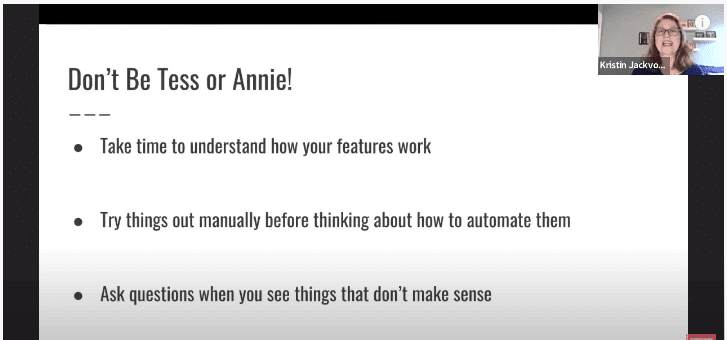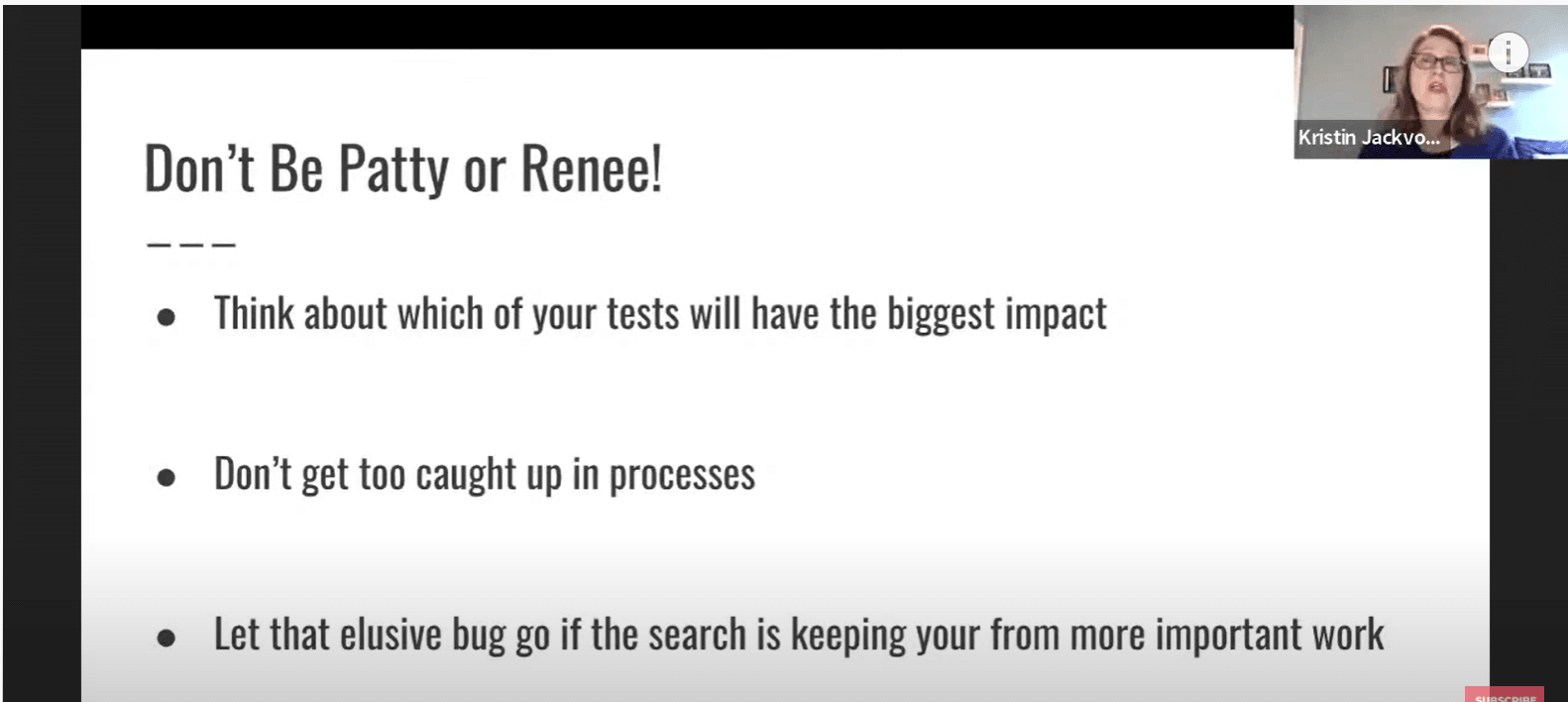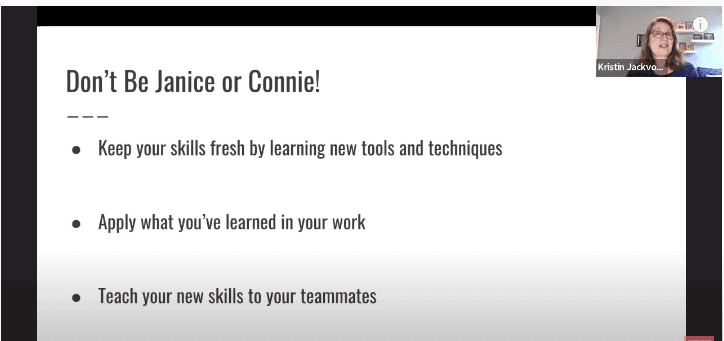Women’s Day Special – AMA (Ask Me Anything)
Shakura Banu
Posted On: March 11, 2022
![]() 14647 Views
14647 Views
![]() 18 Min Read
18 Min Read
Women make up a growing portion of the software testing workforce. Women featured in software testing are brilliant, have practical expertise, and are passionate about software testing. However, they are all members of a global workforce, operating in multiple regions, each with its own set of viewpoints, ideas, and expertise. One of the special days honoring women’s accomplishments is International Women’s Day (8 March).
Therefore, LambdaTest hosted a special AMA session with Kristin Jackvony – Author & Principal Engineer, Quality – Paylocity, and Veena Devi – Lead (Developer Relations) to commemorate this special day and address questions regarding women in software testing on March 8.
Let’s look at the major highlights of this AMA.
TABLE OF CONTENTS
- About the Webinar
- Journey from a music teacher to a software tester
- Contributing knowledge to the community
- Effective time management and planning
- Handling career breaks like a champ
- Kristin’s most interesting areas in Software testing
- What to automate and what not to Automate
- Best tips to upskill yourself
- Celebration of tiny victories
- Tips for dealing with a production bug
- Q&A Session
- Common mistakes in Automation testing
About the Webinar
In this webinar, Kristin narrates her story from a music teacher to a software tester and the challenges she faced to reach there. She explains her idea of contributing to the community. Kristin then offers career guidance to women who have taken a sabbatical for personal reasons or want to change careers after a brief hiatus. Besides, she iterated on the variety of software testing areas covered for amateurs in her book.
In addition, she mentioned her recently published book “𝗧𝗵𝗲 𝗖𝗼𝗺𝗽𝗹𝗲𝘁𝗲 𝗦𝗼𝗳𝘁𝘄𝗮𝗿𝗲 𝗧𝗲𝘀𝘁𝗲𝗿”- which is available in the Kindle format on Amazon. Since it was an AMA session, there were several questions asked by Veena to Kristin related to women in technology, how to handle career breaks like a pro, donning multiple hats in software testing, and much more.
The following is a detailed breakdown of the questions Kristin answered during the entire session.
Journey from a music teacher to a software tester
Kristin started her career as a music teacher and later discovered her passion for software testing in 2009. On being laid off as a software developer, she realized that development was not her cup of coffee. She returned as a software tester from a small intern firm, and she enjoyed the work from the first day and decided to have a long run with her passion for testing.
Kristin is the only person responsible for testing in her firm. She realized that testing was a must for their product. Finally, she started learning test automation as the requirement came in. She stated that she somehow managed to excel in Selenium automation testing, Java, and surfing the web.

Contributing knowledge to the community
Kristin goes on to explain her idea on contributing her knowledge to the community. According to Kristin – she first got the idea of contributing back in 2013. With the knowledge she gathered about Automation Testing, she wanted to put it all down on a blog and share it with others so that anyone may utilize it if they get stuck somewhere.
In 2018, she had a fair amount of followers on the blogs and decided to make a book out of her posts. And there, she slowly started contributing to the community.
Effective time management and planning
Kristin talks about how she manages her time efficiently. Well, it was again a challenge for her, as we all have. Being a mother of four kids and managing to serve as a full-time employee was not a piece of cake for her. Further, she mentions a Full Focus Planner to achieve her goals and how she balances her work-life using it. It extremely helps her in setting up and following her day-day activities, marking her accomplishments, and moving forward. In addition, having the planner helps her to sort out the overwhelming part of the day.
Apart from all these, she has a supportive son who takes care of the laundry when she is engaged at her workplace. A supportive family is a group experience of love and support for every woman.
Handling career breaks like a champ
“It is never too late to return, make a career shift, and begin a new one,” – Kristin Jackvony
Kristin arrived at the decision of being a software tester in her late 30s and agreed to take on an entry-level position to gain the necessary experience. Unfortunately, her first job as an intern paid her next to nothing and offered her zero benefits. However, she never gave up and was confident in her ability to gather experience that would benefit her in the future. As she believed, using her three months experience as an intern, she found a job with fairly good pay and benefits.
“Sometimes it’s worth taking risks to opt for a job with less pay,” she added.
Kristin discusses the importance of utilizing prior experience in your workplace, be it from the previous company or parenthood. She explains how she had taught complex concepts into simple and small components when she was a music teacher. She used the same concept in her book and LinkedIn learning materials. Kristin has learned patience from her parenthood which helped her seek a career shift. She further explains the value of asking questions and how it shows initiative and builds trust. When you voice out when you don’t know something, it demonstrates that you’re mature enough.
Further, she explains her area of interest in testing.
Kristin’s most interesting areas in Software testing
Kristin has covered a wide range of topics that interest her in the book. She strives to make it as progressive as possible in order to make it a useful resource for the folks who are new to software testing. It covers manual testing, tips to consider while testing an application, how an API works, all hands-on activities, a small application to test, and fundamental knowledge of software development and programming.
As people who are new to software testing do not have an idea of how to use the command line, Kristin mentioned that she covers the Git concepts. The discussion then moved on to software automation, including various types of automation, mobile automation, load testing, and security testing. Test planning is crucial because you should be able to build a test strategy and convey it to the stakeholders, not just declare that you understand automation testing. And finally, the soft skills for testers to stay organized and focused during the day.
Read – Key Elements of an Effective Test Automation Strategy
What to automate and what not to Automate
Kristin gives some suggestions and tips on what to automate and what not to automate.
- Do not automate fragile features – Things that are prone to breaking on a regular basis. The test will fail every time your feature fails. So it will be of no use.
- Do not automate features that will change – It is a waste of time to automate the features that need to be changed. However, if you are aware of a stable feature or platform that will be migrated, you may want to prepare an automation script while the code is being corrected to demonstrate that the application is operational.
- Do not automate user interface – UI that needs to be changed – If the entire UI is going to be modified, as well as the endpoint, do not automate because it is a waste of time. Instead, you must repeat the procedure.
- Do not automate weird edge cases – It’s pointless to automate a process that your user will perform on a rare basis. Automate only the crucial cases.
- Do not automate flaky tests – The flaky feature must be distinguished from the flaky test. The flaky feature is extremely delicate and often breaks. The outcomes might arise while testing against highly reliable software. Kristin also suggested avoiding them as they decrease confidence in the test.
When the product undergoes a set of tests, out of which 25% fail, hardly anyone cares about making the purpose of testing pointless. Many things that can be carried out in the flaky test. She also added that her organization uses Cypress, which simplifies the process of test retrying. She exclaims repeated failure in these test cases would end in problems.
Kristin then showcased six software testing personas to avoid and their do’s and don’ts.
Test Script Tess – She just runs her assigned tests without thinking about them!
Maybe she is being asked to run and check the automation script every day. She doesn’t know why she is testing, does not question it, does not think about it, and does not care if it fails.
Automation Annie – Writes automation without considering what it is doing and why!
She loves to write code, but she writes the automation scripts without understanding. She does not care whether she is automating the right feature. She just likes to write the automation and see if it is working.
Issues with both the personas: They do not have an understanding of the task they are doing.

Process Patty – Bogs everything down with lots of processes and rules!
She wants to make sure that the bug is documented and fill out the bug report before testing it. The problem with Patty is that she is slowing down everything.
Rabbit Hole Rene – Spends too much time investigating unimportant bugs!
She is very interested in tiny bugs. When she finds some little obscured bug that she has never seen before and cannot reproduce, she just goes down to find this one elusive bug. And she spends 4-5 days to find the issue when others are waiting for her to complete the prior tasks. Sometimes it is essential to find that elusive bug, but it is essential to look for the other functions as well at the right time.
Issues with both the personas: They are having issues with time. They are so caught up in things that they are actually wasting time that can be used to test other things.

Job Security Janice – Never learns anything new!
She is excelling at her job, understanding the process, and uses the right tool. But, she is not ready to learn new stuff.
Conference Connie – Learns tons of new things but doesn’t apply any of them to her work!
She loves going to conferences, webinars, taking courses, and learning new things. But she never applies that to her work. She might know six different UI test automation frameworks but sticks on to the existing tool.
Issues with both the personas: Both of them need to learn new things and apply them frequently to their work style.

Also, read – Testing Scenarios you should not automate with Selenium
Best tips to upskill yourself
Kristin discusses online learning materials. She learned more about this topic beforehand and was urged not to let cost be a deterrent. She acknowledges having completed a handful of courses from Udemy.com, but Kristin believes there are additional excellent online courses available for free from W3 schools and LinkedIn Learning.
She expressed a few things about her coworker and fresh learning that inspires her. She also mentioned that she spends half an hour at night keeping up with new technology and learning stuff she doesn’t understand.
Read more – 17 Skills Of Highly Effective Software Testers
Celebration of tiny victories
Kristin discovered a method to celebrate small victories by posting them in the women’s tech Slack group. This method of disseminating knowledge to a large group really benefits other women. It becomes more natural for her to share with her coworkers. She, on the other hand, keeps a focus planner to write down a list of accomplishments from the preceding day/weeks. Reading the focus planner tends to pump her up in a better way when she literally falls down for a reason.
Another excellent method is for her husband to print the cover pages of the books she owns and hang them on the wall for her to take a gentle look at to remind her of the amount of hard work that went into it. At all times, the visual appearance of the work conveys a positive mood. Kristin constantly believes in keeping a positive relationship with the individuals she surrounds herself with, which greatly drives them.
Tips for dealing with a production bug
Here are the few tips shared by Kristin on how to handle bugs in production.
- Kristin suggests not to get carried away in a panic situation. Instead, gather as much information as possible and try to put it across to different people. It ensures to cross-verify the bugs found across different browsers to make sure it is a browser-specific one.
- Try and figure out the release versions for better understanding. When a customer issue is raised, she tries to compare the same issue with other customers as well to figure the intensity, and it helps to list out the customers facing the same trouble. It keeps the test data, test scenarios, environment handy to verify the bugs in production post the fix method.
- Performs a root cause analysis to figure out the major reason for it to happen and not to blame others. It’s better to find the cause of the bug and not repeat it in the future.
Also, read – Advanced Guide On Writing A Bug Report
Veena then popped up a question – The majority of projects or products are developed in an Agile environment. How do you propose involving other product or developer teams or product owners in a testing process?
Kristin – It is very crucial to release the software as quickly as possible, and the entire team holds the responsibility on the quality front. Developers should test their work before passing it on to the testing folks to cross-verify in the testing environment, making sure that all the acceptance criteria are in place. It’s also a better idea to think of some edge case scenarios.
After doing all the steps mentioned, the testers come into the picture of the process. Developers should also create a few test harnesses to make use of the process. She strongly suggests each and every one of them in the team should try and understand the product and the manual testing methodologies.
Read – 34 Ways To Save Time On Manual Cross Browser Testing
Kristin had a co-worker who was a software tester and then moved to an engineering management role managing the agile team. She followed a best practice for all new joiners with a list of guide items to start using the application from a customer standpoint. This throws importance to understanding the application better.
Also, Kristin encourages the whole team to perform exploratory testing together prior to the release. Here the understanding of the product grows periodically. Developers should get involved in automated testing and fixing the test scripts. Having a single person in the team to create test suites, would probably become a bottleneck. So it is advisable for everyone in the team to be aware of how to run a script, how to test and debug it. When the above points are achieved, a team can be efficient enough in the overall product delivery method.
Now let’s jump into the Q&A session!
Q&A Session
Before wrapping up, Kristin answered a question raised by a viewer.
How do you get a team on board with everyone whose quality should there be resistance?
Kristin – It entirely depends on the size of the company. In my company, we have started an initiative where my significant role is to guide all the teams to adopt this mindset. As part of this, we have created a quality maturity model that outlines many different behaviors that the team should be doing to have that whole quality mindset. For example, when a developer makes a pull request, they ensure to mention what features they have touched, or everyone on the team should know how to do a deployment.
If you have a minor team or do not have such initiative, it is essential for the developers to understand that what you all are doing together makes their tasks more manageable. There might be a reaction to this where the developers say, why should I test when my job is to code, and the tester’s job is to test. You can justify this by saying that if a bug is found two weeks after the feature is developed, the developer needs to go back and remember what they have done to fix the bug. If the bug is found sooner, it would be easier to fix. So having a whole team on quality means that the bug can be resolved more shortly and faster, where there is more time for the developer to start working on new tasks.
Another thing is you can set up processes that make the team work easier. In my company, we have handsfree deployment, where the tester sets the automation script, and then they put that to run automatically during the deployment. So if we have a nighttime deployment, people do not need to sit in front of the systems to watch that run. The tester can get the notification on their phone or laptop screen if the test fails so that they can go and check. Hence working together makes the team work more quickly effectively and delivers the product of higher quality.
Kristin then discussed about the common mistakes in automation
Read – Why Test Automation Fails? Top Reasons (+ Solutions)
Common mistakes in Automation testing
Kristin shares the common mistakes one makes while performing test automation.
- Writing an automation script without understanding the product. If someone gives you a feature and asks you to do automation testing, and if you don’t understand the product, you would be automating the wrong thing entirely, which is a mistake.
- Before writing the automation, try to understand what that feature does, why it is doing what it is doing, what the customer will gain from this, and the scenarios or the customer journey that the customer will typically do.
- Don’t write so much UI automation; instead, analyze how much you can test using APIs. A lot of software has many complicated business rules, do not test those through UI automation; instead, use API or database calls. Do the UI testing at the unit test level or using API. This would make your test more reliable.
- It is vital to use the resources that you have in your team, like the developers. They understand your automation script better than you and will help you structure the code.
Finally, the Kristin shares her favorite women influencers in tech industry –
- Elisabeth Hendrickson – She has written a book called Explore It. It is all about exploratory testing. If you want to become a good tester, reading this book will definitely help.
- Lisa Crispin– She wrote a book called Agile testing that talks about the best way to test the product when you are in the Agile team. She has also written a long book and a short book, Agile Testing, which is cheaper.
- Angie Jones – A great explainer of things. Having known her before, It would have been much easier to do the job rather than trying to figure out things on her own. Angie has started a free site called test automation university that provides all kinds of free automation courses that you can take. If you ever get a chance to see the video, then that would be definitely great.
- Marie Drake – A real expert in cypress and accessibility testing. She has a blog and also presents the compares worth checking out.
- Beth Marshall – Does a lot of stuff on Postman.
- Maaret Pyhajarvi – She gives training to new testers and talks about many exciting concepts like peer testing and group testing.
- Lisi Hocke – a frequent speaker and blogger. Recently she has published a new article on starting a new job. This book talks about what you should consider when starting a brand new job as a tester.
Conclusion
We hope you enjoyed the webinar. Women in tests like thought leaders, founders, and entrepreneurs are propelling the kind of future we want to be a part of. To know more about them, you can refer to our blog on 7 influential women in test to follow today.
Stay tuned for more intriguing webinars. You can also subscribe to our weekly newsletter – Coding Jag to remain up to date on everything around testing and more!
Got Questions? Drop them on LambdaTest Community. Visit now










